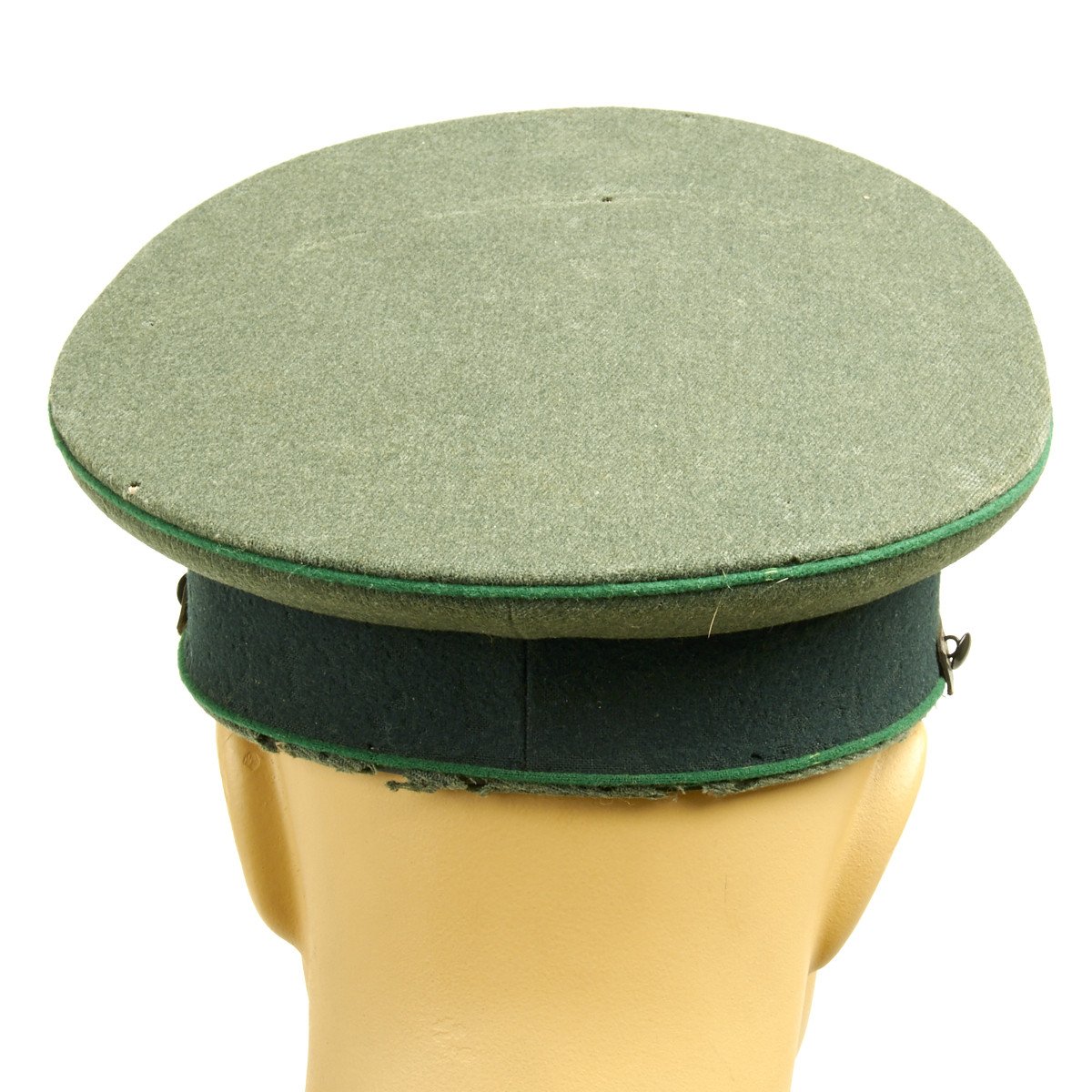Original German WWII 99th Gebirgsjäger Regiment Mountain Troop NCO Visor Cap – Dated 1935 Original Items
$ 795,00 $ 238,50
Original Items: One-of-a-kind. Early Third Reich Wehrmacht Heer Gebirgsjager visor hat maker marked OTTO SCHLIENTZ, STRAUBING. This Jager peak visor cap has a fine field moleskin wool crown, with dark green wool cap-band and green piping. The peak visor cap retains a metal eagle and swas badge, plus a fine set of zinc/aluminum oak leaves with cockade. The inner lining is champagne color with full celluloid diamond and a size 55 ink stamp. The visor retains all of its finish both on top and beneath. The tan synthetic leather sweatband is fully intact. This Gebirgsjäger Officer peak visor cap is in near excellent condition with only a few very minor moth nips.
Inside the sweat band there are multiple ink stamps as follows:
Carl Nordman
Lederfabrik
15 Jan 1935
It is also stamped:
7/J.G 1936
As well as:
OTTO SCHLIENTZ, STRAUBING
These markings stand for the 7th Kompanie/Gebirgsjäger Regiment 99 (part of the 1. Gebirgsjäger Division)
The 1st Mountain Division (German: 1. Gebirgs Division) was an elite formation of the German Wehrmacht during World War II, and is remembered for its involvement in multiple large scale war crimes. It was created on 9 April 1938 in Garmisch Partenkirchen from the Mountain Brigade (German: Gebirgs Brigade) which was itself formed on 1 June 1935. The division consisted mainly of Bavarians and some Austrians.
The 1st Mountain Division participated in Operation Barbarossa, (the invasion of the Soviet Union). On 30 June, the division captured Lvov. There, the Germans discovered several thousand bodies of prisoners who had been executed by the NKVD, as they could not be evacuated.[2][3] As the news spread, a large-scale anti-Jewish pogrom broke out, in which the town’s Ukrainian population participated, stirred up in part by the German and Organization of Ukrainian Nationalists (OUN) posters and proclamations calling for revenge against the “Jewish Bolshevik murders”.[2][3] The 1st Mountain Division continued its advance into the Soviet Union, participating in the breakthrough of the Stalin Line and the advance to the Dniepr and Mius rivers.[1] In May 1942, the division fought in the Second Battle of Kharkov and then participated in the offensive through southern Russia and into the Caucasus (Operation Edelweiss).
In a symbolic propaganda move, the division sent a detachment to raise the German flag on Mount Elbrus on 21 August. Although the feat was widely publicized by Goebbels, AH was furious at this.[4] After the Caucasus campaign the division was posted to Yugoslavia, where it participated in the anti-Partisan offensive named Case Black, and later Greece where it took part in anti- partisan operations. In November 1943, the division returned to Yugoslavia, where it took part in operations Operation Kugelblitz, Schneesturm and Waldrausch. In March 1944, the division was engaged in the Operation Margarethe (German occupation of Hungary). After the operation Rübezahl in Yugoslavia in August 1944, the division took part in defensive fighting against Red Army in Belgrade Offensive, and suffered severe losses. During the operation, the division commander, general Stettner, was killed in the battle on 17 October on Avala mountain near Belgrade. In late November, it was transferred in Baranja, to the most endangered spot of the German defense.
It was renamed 1. Volks-Gebirgs-Division in March 1945. Its final major operations were near Lake Balaton (Operation Spring Awakening) against the 3rd Ukrainian Front. Two months later the shattered division surrendered to the Americans in Austria.
This is truly excellent condition cap, regimentally marked, maker marked with a very early January 1935 date! Talk about rare.
Fast Shipping with Professional Packaging
Thanks to our longstanding association with UPS FedEx DHL, and other major international carriers, we are able to provide a range of shipping options. Our warehouse staff is expertly trained and will wrap your products according to our exact and precise specifications. Prior to shipping, your goods will be thoroughly examined and securely secured. We ship to thousands clients each day across multiple countries. This shows how we're dedicated to be the largest retailer on the internet. Warehouses and distribution centres can be located throughout Europe as well as the USA.
Note: Orders with more than one item will be assigned a processing date depending on the item.
Before shipping before shipping, we'll conduct a thorough inspection of the items you have ordered. Today, the majority of orders will be delivered within 48 hours. The delivery time will be between 3-7 days.
Returns
The stock is dynamic and we cannot completely manage it because multiple stakeholders are involved, including our factory and warehouse. So the actual stock may alter at any time. It's possible that you may not receive your order once the order has been made.
Our policy is valid for a period of 30 days. If you don't receive the product within 30 days, we are not able to issue a refund or an exchange.
You can only return an item if it is unused and in the same state as the day you received it. You must have the item in its original packaging.
Related products
Uncategorized
Uncategorized
Uncategorized
Uncategorized
Uncategorized
Uncategorized
Uncategorized
Uncategorized
Uncategorized
Armored Burgonet Helmet & Polearm from Scottish Castle Leith Hall Circa 1700 Original Items
Uncategorized
Uncategorized
Uncategorized
Uncategorized
Uncategorized
Uncategorized
Uncategorized
Uncategorized
Angolan Rebel 1970s era 60mm Inert Display Mortar from Angolan Civil War Original Items













































































